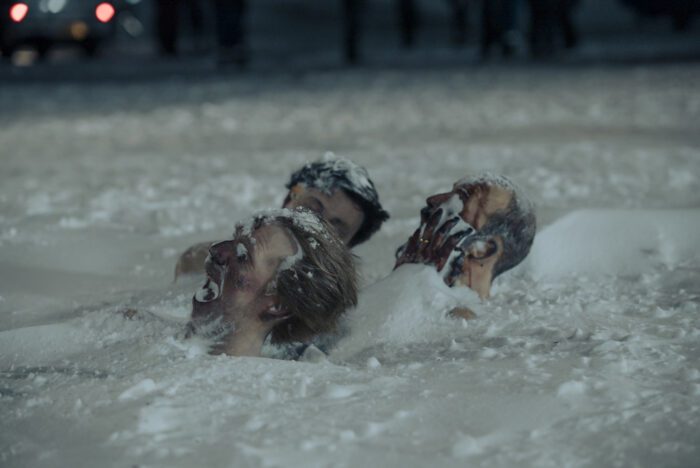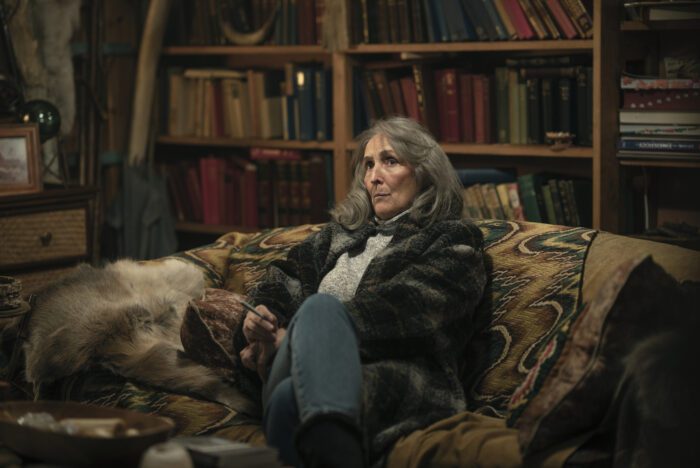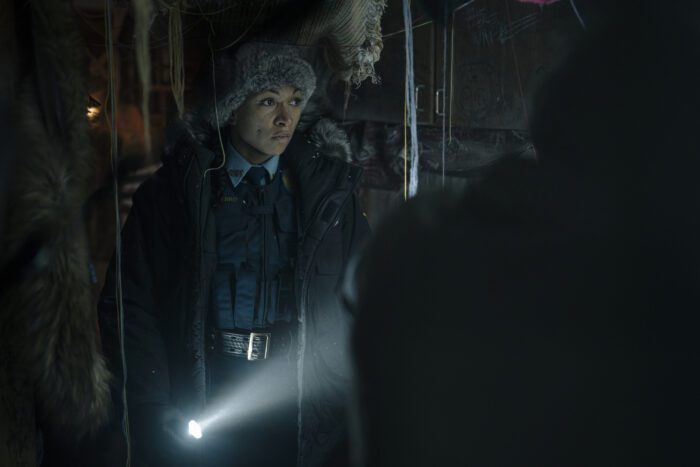The following recap contains spoilers for True Detective: Night Country Part 2 (written and directed by Issa López). Some elements of True Detective Season 1 are also discussed.
True Detective: Night Country may open with the mysterious disappearances of eight men from the Tsalal research station in Ennis, Alaska, but that’s far from where the story begins. We learned in Part 1 that Chief Liz Danvers and Trooper Evangeline Navarro had a falling out of sorts six years ago, but the story still begins long before that. There is decades-long resentment between the migrant workers of the town and the Native population, but that’s still not close to where the story begins.
Now that the connection between the two has been codified, True Detective: Night Country begins where Season 1 of True Detective ended; with the understanding that the oldest story known to man is where we must look to find the origins of this fourth season.
“It’s just one story…The oldest. Light versus dark.”
Those words that Rust Cohle tells Marty Hart at the end of True Detective Season 1 establish the starting line for True Detective: Night Country. Even the answers of “who” or “what” committed these crimes might not provide satisfactory answers to the mystery because the “why” has been established. There is darkness and evil in this world and it has been doing battle with the light since before the beginning of time.
But the right questions must still be asked to uncover the mysteries, as is clearly defined as one of the themes of this episode. Chief Danvers relentlessly prods young officer Pete Prior to “ask the right question” or to determine “what’s the better question” in this episode as the connected pieces of the tapestry of this crime, this town, and these people begin to be woven in Part 2.
As stories, worlds, and histories begin to merge in this episode, True Detective may have already answered the question of “why” these eight men disappeared or why Annie was brutally murdered six years ago. Darkness exists, and as Marty tells Rust, it “has a lot more territory.” But the “what” and the “how” are still open for broad interpretation; we just have to make sure we are asking the right questions.
As Danvers and Prior brush off the frozen corpses for evidence, the episode opens with burnt eyeballs, ruptured eardrums, broken bones, self-mutilated body parts, chewed-off fingers, and one symbol. One of the deceased researchers has a spiral drawn on his forehead—the same spiral that appeared throughout Season 1 and appeared briefly in Season 3 of True Detective. This confirmation of the connected universe between the three seasons is just the first of several call-backs to previous iterations of the show.
Later, as was widely speculated, it is confirmed that the Travis that we see in Part 1 that leads Rose and the authorities to the bodies is, in fact, Travis Cohle, Rust Cohle’s father that was referenced in Season 1. Later, Danvers and Navarro will discover a number of string and stick toys that appear eerily similar to the toys that Detectives Hays and West find in the Arkansas woods while searching for two missing children. The frozen bodies found in the Alaskan tundra harken back to the bodies of both Dora Lange (S1) and Will Purcell (S3), whose bodies were placed in a certain way to “freeze” them in various pious positions.
This now-certain connection within the larger True Detective universe serves to first deepen the understanding of the context in which the Tsalal research station murders take place and, second, widen the mysteries that are now linked between Seasons 1, 3, and 4 around nature and meaning behind such gruesome murders and crimes.

When Danvers and her team decide they want to keep this “shitbowl” of an investigation into these deaths in Ennis, they move the frozen block of dead scientists to the local ice rink to wait for them to thaw and also to continue to search for evidence in and around their bodies. Captain Connelly (Christopher Eccleston) has also come to town to supervise and insists that the case be moved to the state authorities in Anchorage, but Danvers explicitly refuses, stating that Alaska forensic law forbids them from moving frozen bodies for at least 48 hours after they that so as to preserve any evidence of the crime.
Danvers’ insistence that they keep this investigation local is interesting, especially because she keeps referencing how awful it is going to be. Does she feel remorse or regret for declaring the Annie cold case “unsolvable” six years ago and does she feel some responsibility for the obsessive state Navarro finds herself in as she can not give up on trying to find the killer of the local young activist?
Danvers’ apparent 19-year intimate relationship with Connelly seems to be the only thing keeping the Captain from yanking it right out from underneath her, but he certainly feels less confident than Danvers that the group of sometimes less-than-professional deputies at her disposal can solve this, especially since they may not just be dealing with a “who” done it, but rather a “what” done it.

While Danvers and the younger Prior are trying to navigate the forces seeking to take the investigation away, Navarro visits Rose as she continues to pursue leads on Annie’s case. It’s at this meeting in Rose’s house that we make the official connection that the man Rose lived with and was in love with was Travis Cohle. Rose doesn’t see him often, and it’s only when Travis “wants something,” but Rose does have to admit that the one good thing about Travis’ death is that Navarro found him and the two were able to create a bond.
As they depart, they discuss something that they both saw: the spiral pattern on one of the victims’ foreheads. Navarro has seen it before, and Rose knows that it means there is evil among them.
“It’s old. Older than Ennis. Older than the ice, probably.”
The story of these deaths starts long before these men disappeared from their research station. The same spiral that was on the head of the victims was tattooed on Annie when her body was discovered.
After some digging into the victims’ phones and some interviews with the cleaning ladies and the delivery man who discovered the empty research station, the investigation begins to shift towards Raymond Clark. Over time, Clark, one of the researchers, began acting strangely. He was the researcher recorded in Part 1 saying “She’s awake,” the cleaning ladies noticed him acting odd, other researchers were ignoring him, and the delivery driver saw him hanging out in the station one time “skinny ass,” with no clothes on at all.
It’s at this moment Peter Prior learns Clark also had the spiral tattoo on his chest. This leads Prior and Danvers down a rabbit hole of Clark’s past that will eventually intersect with Navarro’s ongoing cold case investigation. Navarro, after questioning a local miner who got into a fight with a Native in town, learns Clark bought his cousin’s camper trailer seven years earlier. Danvers also learns that Clark got the tattoo four days after Annie died and he used a picture of her as the model for the tattoo artist to apply it to his chest. The connection to Annie bring Danvers back to Navarro, who shares the information about the trailer Clark purchased years before.

The two adversaries decide to put aside their differences so they can follow the Clark thread and hopefully close their respective cases, which can then finally lead to them going their own ways forever. Locating the trailer Clark bought so he and Annie could secretly rendezvous, they also discover a large spiral painted on the ceiling as well as countless string and wicker dolls that fill the bed and empty spaces all over the trailer.
As disturbing as that discovery seems, Prior calls Danvers with even more horrific news. The bodies have thawed enough to take an account of which men are there. One researcher went to the hospital in an induced coma. Six men are accounted for in the ice. One man is missing, and no one among the victims has a spiral tattoo on their chest. Raymond Clark is missing, and he is now the lead suspect in both the deaths of his co-researchers and Annie from six years ago.
This being True Detective, and with four episodes still to go, the answer to these mysteries is very unlikely to be this simple or perfunctory. These uncovered details and clues are meant to distract us from what Danvers is encouraging us to do all along: Ask the right questions. With the expansion of the universe and the mythology of the evil behind the spiral in True Detective seasons, we are likely searching for a “what” question, instead of a “who.” Raymond Clark is possibly evil. What made him that way? Why did it make him that way?
Looking back to the conversation between Rose and Navarro from the beginning of the episode, Rose says something very intriguing to Navarro about how to deal with these unexplained mysteries like seeing Travis appear to her even though he is dead. How to make sense of the senseless. She tells Navarro,
“The world is getting old. And Ennis is where the fabric is coming apart at the seams.”
If the battle of light versus dark is the oldest thing that exists, it’s entirely possible that evil has found its way to Ennis (or always existed there) and the worn-out seams brought upon by a never-ending night are now allowing the evil to penetrate the town, and its people. The darkness is winning over the light in Ennis.
Raymond Clark may be the answer to one question, or even several questions. But are they the right questions?


Great review
Thank you for checking it out!